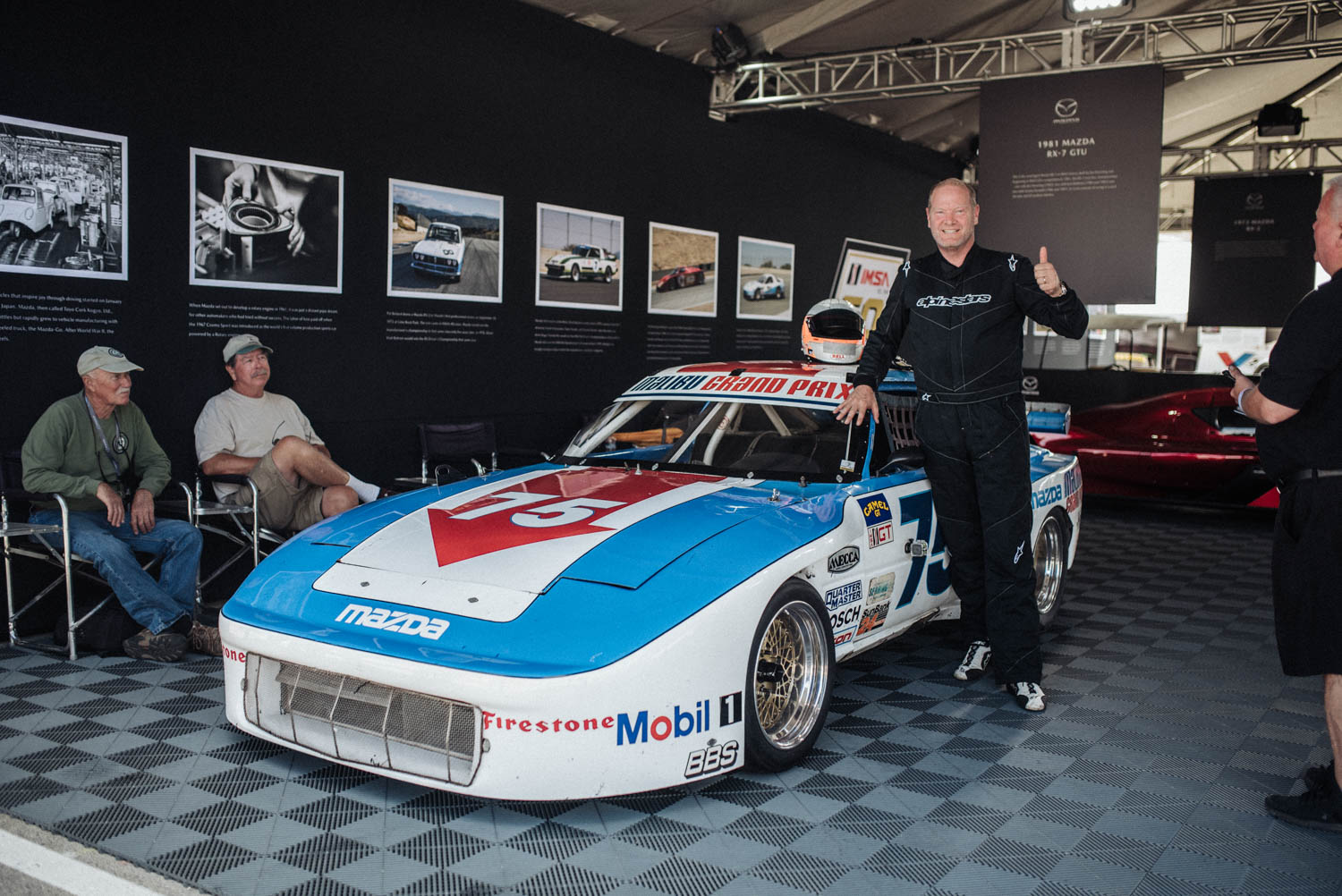Media | Articles
RX-7 reunion: Kendall and Binks take on Laguna like it’s 1986
After 34 years, a reunion between a legendary trio of driver, crew chief, and race car played out at the 2019 Monterey Historics. Making it more special was the track, Laguna Seca, which was the location of the trio’s first win; and the series, IMSA, which was celebrating its 50th anniversary. It was the perfect setting to reflect on the journey this driver and his crew chief experienced over three decades to become two of the most important and well-known figures in the history of sports car racing. But the real surprise was the car. It had been locked in a virtual time capsule for 31 years, and it showed up at Laguna virtually identical to when it pulled off the track after its final race in 1988.
Here’s how it all came to be.
In 1986, a 19-year-old kid studying economics at UCLA ended up strapping himself into the recently vacated driver’s seat of a Mazda RX-7 to race in the IMSA GTU class. The kid? Tommy Kendall. The driver who gave up his seat? Jack Baldwin, who went to drive for Chevrolet. Even at 6’6” Kendall had some damn big shoes to fill. Between his studies, that is.
But before all that, Kendall had to prove he could drive. By all reports, Mazda wasn’t too sure this plan would work out, agreeing to sponsor the teenager one race at a time. There were no concerns with the car, of course—the RX-7 was a proven winner. Built by Downing/Atlanta Racing, the car had already been competing in the IMSA GTU class since 1982 and kicking ass, including a win at the 1982 IMSA GTU championship with Jim Downing, followed by Jack Baldwin’s 1984 and 1985 IMSA GTU titles.
Perhaps even more wary than Mazda was a young Dan Binks, who had just started his first real motorsports gig crewing for this RX-7 team. “I worked on the car for the 1985 season when Baldwin was driving it and we won the championship. Then Jack left and Tommy came in. I didn’t know him, he seemed like a nice kid but none of us knew a thing about him beyond that he was going to UCLA and his dad was paying the bills for him to race. We hit it off OK but I honestly was pretty worried about it. And my wife said, ‘Great. You just got going and now this kid is going to ruin your career!’”
Marketplace
Buy and sell classics with confidence
The first few races, by Binks’ account, weren’t great. “After [Kendall’s] third or fourth race when he finished in third place, we asked him, ‘are you OK?’ That seemed to square him up and then he started going fast. Really fast.” After that, it was clear nobody needed to be concerned.
Kendall proves his mettle with the Mazda RX-7
20190925150218)
Kendall ended up winning at Laguna Seca in this RX-7, scoring a full deal from Mazda in the process. And like that bunny with the batteries, he just kept going. Kendall won the 1986 and 1987 IMSA GTU championship in the RX-7, making him the youngest champion in IMSA history, followed by three other titles. All of which, combined with the car’s earlier history, would end up making it the winningest RX-7 of all as well as one of the most successful chassis in all of sports car racing. In total the car won five season championships and 21 race wins, including Rolex 24 and Sebring 12 Hour wins in 1984.
As for the Binks and Kendall relationship, that too would become the stuff of legend. “Once it was clear Tommy could drive it just got better and better, especially our communication,” says Binks. “I think we ended up being a phenomenal pairing.” The number of championship wins to the duo’s credit backs that up, and both are now considered motorsports royalty. Binks is regarded as one of the finest crew chiefs of all time, and Kendall, Motorsports Hall of Fame driver, still holds the record for consecutive race wins with his 11 in a row in his Roush Mustang during the 1997 Trans-Am championship. With Binks as his crew chief, of course. The pair seemed simply unstoppable.
The fate of Kendall’s RX-7 race car

Championships or not, nothing is older than last year’s race car, as the old yarn goes. That was true of Kendall’s RX-7, too. A five-year-old race car? Toast. They typically end up going down a slippery slope through amateur racing and, eventually, hitting the junk pile. By some fortuitous twist of fate, however, this RX-7 escaped all of that.
“It was retired after the ’88 season,” Kendall explains. “After the ’87 season, when I signed with Chevy, my dad bought the car from Clayton Cunningham (for $15K) and loaned it back to Clayton for the next season to help him out. When I graduated from UCLA in ’91, my dad gave it to me.”
Why did Kendall keep it all these years? “It was mostly for sentimental reasons, but I was also as a fan of the car before I drove it,” he says. “ I watched both Jim Downing and Baldwin race it. On some level, I also knew its significance to Mazda and as the winningest car in IMSA history. For a single chassis to win five titles was hard to fathom even then. To be honest though, I kind of forgot about it. It was stashed along with my other cars, all my trophies, suits, and memorabilia while I was busy racing. About five years ago, when my dad needed it cleared out of where it was stored, it was like a barn find, but in my own barn. So I never even had to find it or buy it back!”
Resurrecting the RX-7
20190925150254)
Beyond clearing out the storage building, there was perhaps a little more motivation to get the old RX-7 cleaned up and running again. Binks and Kendall remain close to this day, and Kendall describes a perfect storm of a situation: “Having to move the RX-7 out and find a place for it about five years ago was really the catalyst. It went back to Binks, and Binks being Binks, he started working on it. That’s really what got things rolling. Then being invited to the Amelia Island Concours created a deadline to go through it and make it presentable, and then the IMSA 50 to get it track-ready.
“When we started prepping it for Amelia, Binks asked what the plan was and I said ‘clean it up but leave everything like it was when it drove off the track the last time.’ He asked if he could vacuum the cat hair out of the seat. My cat, Betty, who was rescued from humane society across the street from the shop to cheer me up after my accident, used to hide out in #75 when I lived at the shop for a couple years.”
Although, in the spirit of journalistic integrity, I have to be clear that when Binks heard this explanation he said, “it was a lot more than just cat hair. I’ll leave it at that.”
Back at Laguna

After Amelia Island, the push was on to get the old warhorse ready for the IMSA 50th Anniversary at the Monterey Historics this past August. The car would be featured, Binks would return to his role of its crew chief, and Kendall to his role of hot shoe.
Hindsight is 20/20, so I asked Binks what he thought of the RX-7 after working on it three decades later, once it had been removed from what was essentially a time capsule. “At the time (in the 1980s) we thought it was pretty good,” he said. “It was one of the fastest RX-7s out there. The best part was back then you could still take your car home and work on it, cut stuff up, make it better. If you did better work than the other guys you would win, there was nothing like the BOP (balance of performance) stuff of today. Looking at the car now we realize how primitive it is. We didn’t know any better back then. If I could go back and just use what we’ve learned in the decades since I bet there is easily another five seconds in the car. Don’t tell TK that, though!”
As for Kendall, after getting reacquainted and racing his first real race car again all these years later? “[There has been] a lot of water under the bridge since then, but it was fun to drive the car again and even better to do it with Danny wrenching on it and to reminisce with him. It is wild to think that my career and the crew-chiefing career of the greatest sports car crew chief in history began on the same old RX-7 that arguably should have already been out to pasture back then. I think we’re both glad it wasn’t.
“As for the car, I was wondering what it was going to be like to drive it after all these years, given that it was kind of a tired, worn-out piece even when I first drove it. It had 300 hp and no torque, was a flexi flyer, not to mention I drove a lot of really great stuff in the years since. Real race cars. But the RX-7 was about how I remembered it—a real handful and hard work to make it go quick. With no in-car cameras [back then], this was the first time anyone else got to see that. That said, it sounded even better than I remembered and brought back a ton of really great memories from the years that turned me into a pro.”
It was a reunion better than anything even Hollywood could dream up. As if time had stood still since 1986, there was Binks spinning the wrenches and Kendall behind the wheel, playing with the winningest car in IMSA history as if it were just another race car. After all, in the days before it was an IMSA legend, Binks and Kendall were simply its crew chief and driver, still wet behind the ears and yet to be the legends they’d become as well. For us who were lucky enough to stand witness to this reunion, it was a heartwarming reminder that sometimes the right people, and the right cars, forge a bond that time can’t erase.
20190925150234)

















